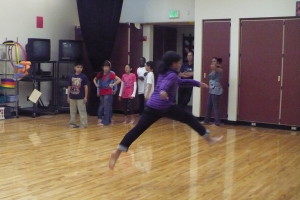This entry was written for ALT/space, online forum of the Teaching Artists Journal.
I’ve been honored to be a contributor to the TAJ online exchange of ideas since last August, even as I’ve felt sort of odd-man-outish. Being a certified dance specialist, located in one school for the past fifteen years, my context is quite different from itinerant teaching artists, especially in the most recent (and most stultifying) educational environment. I’ve lived the conflict inherent between teaching dance as a fine art and teaching in the public school system, having been an itinerant teaching artist in studios and schools through my 30s, before becoming certified in my 40s.
While working within the public school system, I’ve advocated for the place of dance education by participating fully in the process of reshaping dance as a content area (e.g., creating grade level standards and expectations, writing assessments, aligning curriculum, integrating other academic subjects). I attend all building leadership meetings and budget planning meetings; I facilitate a professional learning community and district curriculum alignment team. While all these measures seem necessary in order to carve a place for dance in public schools, there remains the struggle to nurture what I know and love about my art form, in order to share it with children who deserve a chance to dance.
This conflict – between maintaining the life force of dance and molding dance as an understandable content area – jumped into my thoughts upon reading a recent article in ALT/Space: “Alone We Can Do So Little” by Victoria Row-Traster. Never mind that her main point (a wonderful discussion about how a team of teachers can enliven the teaching/learning interaction) is moot within the public school setting, where budget constraints always limit the teacher/student ratio. What caught me was her portrayal of the real goal of teaching art – the spark. I’ve modified her words here in order to apply them to myself:
“During planning, [I] think about the intended “spark”…. [I] ask [myself] how… do [I] plan on capturing each student’s imagination in order for them to be fully immersed in the work? This challenge is amplified when you include the expectations of the classroom teacher… And often, this is all in 45 minutes! In other words — how do we “hook” the kids?”
For me, this conflict plays itself out on a daily basis. I try to plan units that include formative and summative assessments, units that also meet the state’s grade level expectations, including daily teaching points that encourage students not just to dance but to think and verbalize what they know about dance. At the same time, I try to get the kids moving, give them a chance to be swept along by the flow of creating, and dancing together – experiencing the spark that has kept me dancing all these years.
Some days it’s a hard go. But sometimes it works. On Wednesday this past week, I needed to try out some newly-written assessments, intended to gather data for writing grades on our newly-written dance report cards. But I also desperately needed, for myself and the kids, to get them dancing again. In a whimsical moment, I decided on my teaching point: “Leaping lizards! It’s leap year!”
We warmed up with a moving pattern they already know and love, I added an extra warm-up to get them ready for jumping, and we took off across the floor: skips, leaps, diagonal leaps, leaps in crossing diagonal lines. After a good bit of exuberance, we settled into a task of choreographing a haiku by the poet Meisetsu:
A river leaping,
tumbling over the rocks roars on…
as the mountain smiles.
I got some assessment data by videotaping the results but, most importantly, there were a lot of smiles from me and from the kids, as the class unfolded! The spark was lit — by humor, whimsy, the exuberance of moving full-out, and we all felt it. It’s great to experience what we’re really after… so onward…

I love that idea, of using a short poem to structure and inspire their exploration! I was noticing today that I have so many books of kid-friendly poetry, and I don’t put them to good use. Perhaps its time for some in-depth creation/exploration.